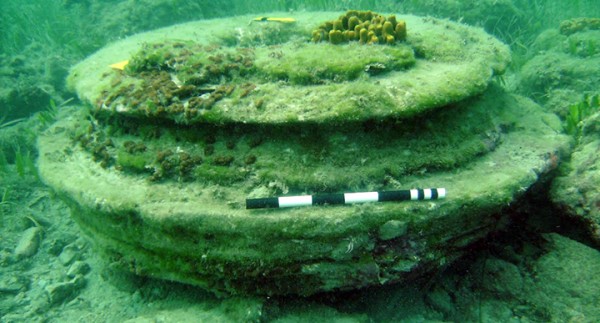Long Lost Underwater Greek City? Nope, Just Act of Nature
| Ana Verayo | | Jun 03, 2016 04:36 AM EDT |
(Photo : UEA) Lost underwater ancient civilization? Just geological formations.
An underwater, lost Greek city was found hidden off the island of Zakynthos, as divers spotted some structures on the sea floor resembling courtyards, paved floor and colonnades, which eerily resembled a lost ancient civilization.
However in this new study, these remains were confirmed to be only underwater geological formations that emerged from rocks, due to methane seeping from the seabed, according to scientists from University of East Anglia, U.K. and University of Athens in Greece.
Like Us on Facebook
In this new study, these structures were determined to have formed some 5 million years ago during the Pliocene era, which also solves the mystery why the divers did not recover any other artifacts indicating a lost civilization, some two to five meters underwater, such as pottery.
Scientists then carried out chemical and mineralogical tests and concluded that this "ancient Greek city" is apparently not what it appeared to be but was just produced from the Earth's natural gas leaks. This natural event usually occurs in a span of hundreds of thousands of years in the deep depths of the ocean.
According to lead author of the study, Julian Andrews from the University of East Anglia's School of Environmental Science, this disk and doughnut like morphology could appear like the base of circular columns however, this is typical of a mineralization process as hydrocarbon continue to seep through the seafloor from paleo times to modern day.
Scientists say that these doughnut shaped formations that easily resemble columns or courtyards are most probably caused by a subsurface fault that has not yet fully ruptured from the surface of the seabed, where this created a crack causing gases such as methane to escape from under the seabed.
Researchers also say that this carbon detected in this methane became a source of food for microbes, creating a process known as concretion. Microbes then promoted oxidation that transformed the sediment into dolomite, which is a natural form of cement, which has been exposed on the seabed from erosion.
This new study is published in the journal Marine and Petroleum Geology.
Tagsunderwater greek city, lost underwater ancient greek city, geological formations, ancient greek city
©2015 Chinatopix All rights reserved. Do not reproduce without permission
EDITOR'S PICKS
-

Did the Trump administration just announce plans for a trade war with ‘hostile’ China and Russia?
-

US Senate passes Taiwan travel bill slammed by China
-

As Yan Sihong’s family grieves, here are other Chinese students who went missing abroad. Some have never been found
-

Beijing blasts Western critics who ‘smear China’ with the term sharp power
-

China Envoy Seeks to Defuse Tensions With U.S. as a Trade War Brews
-

Singapore's Deputy PM Provides Bitcoin Vote of Confidence Amid China's Blanket Bans
-

China warns investors over risks in overseas virtual currency trading
-

Chinese government most trustworthy: survey
-

Kashima Antlers On Course For Back-To-Back Titles
MOST POPULAR
LATEST NEWS
Zhou Yongkang: China's Former Security Chief Sentenced to Life in Prison

China's former Chief of the Ministry of Public Security, Zhou Yongkang, has been given a life sentence after he was found guilty of abusing his office, bribery and deliberately ... Full Article
TRENDING STORY

China Pork Prices Expected to Stabilize As The Supplies Recover

Elephone P9000 Smartphone is now on Sale on Amazon India

There's a Big Chance Cliffhangers Won't Still Be Resolved When Grey's Anatomy Season 13 Returns

Supreme Court Ruled on Samsung vs Apple Dispute for Patent Infringement

Microsoft Surface Pro 5 Rumors and Release Date: What is the Latest?











